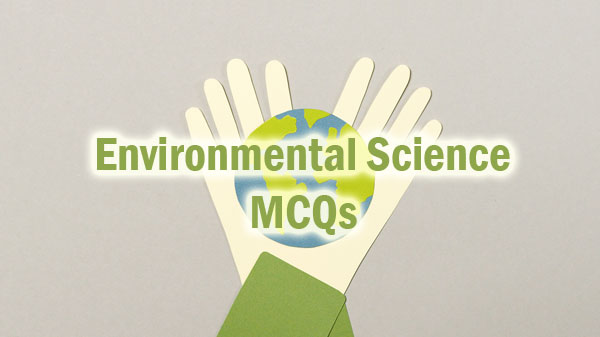Environmental Studies Test Papers
Download all Environmental Studies Test Papers here. We are providing Environment Science Test Papers. We have given the solutions for EVS solved Test Papers to make your preparation efficient. Click here to Download the Environment Science Test Papers from the attached pdfs. EVS Test Papers attached in the PDF Format so the aspirants can download quickly.

Along with these Environmental Studies Test papers, we have attached Environment Science Syllabus and Exam Pattern. Environmental Studies Test Papers are available. Applicants can download EVS Test Papers. Also, get the Study material, Preparation tips in addition to the EVS Test Papers for posts. On our page, we provide Environmental Studies Test Papers for the sake of aspirants.
Test Papers on Environmental Studies
1. Xerophytes are the plants growing
(A) Ocean
(B) Desert
(C) Intertidal zones
(D) Wetlands
2. The best known and accepted theory of chemical evolution suggesting that life began on earth’s surface in areas where organic chemicals are accumulated, is :
(A) Oparin-Haldane theory
(B) Haldane-Khurana theory
(C) Miller and Harold theory
(D) Maxwell and Miller theory
3. Which of the following terminologies is associated with the vertical structure of the forest ?
(A) Canopy
(B) Understory
(C) Forest floor
(D) Back store
4. Which one of the following satellites is an example for active remotes sensing ?
(A) IRS ID
(B) RADARSAT
(C) LANDSAT
(D) SPOT
5. Which process provides most of the oxygen found in earth’s atmosphere ?
(A) Aerobic respiration
(B) Photosynthesis
(C) Fermentation
(D) Ecosystem
6. Landscape ecology is best described as study of :
(A) Abiotic factors and the community of species
(B) Related arrays of ecosystems
(C) Physiological and behavioural ways in which organisms meet the challenges of their environment
(D) The array of interacting species within a community
7. Psychrometer is an instrument used to measure :
(A) Amount of actual evapotranspiration
(B) Atmospheric pressure
(C) Relative humidity of air
(D) Relative density of liquids
8. Tundra biome is characterised by :
(A) Stunted trees and permanently frozen subsoil surface
(B) Lack of trees and permanently frozen subsoil surface
(C) Evergreen trees and permanently frozen subsoil surface
(D) Coniferous trees with subsoil surface
9. The environmental lapse rate is found to be :
(A) 6.5°C/km
(B) 8.6°C/km
(C) 6.5°C/km
(D) 5.6°C/km
10. Groundwater resources are mainly becoming scarse because of :
(A) Lack of rain
(B) Excessive rains
(C) Overexploitation
(D) Low percolation
11. Ocean salinity is low in the equatorial region, because :
(A) the region is characterised by heavy rainfall, cloudiness and humidity
(B) the region contains evergreen forest
(C) the region is covered by lavas of younger ages
(D) the region is covered with good agricultural land
12. In the spectral distribution of the solar irradiance at the earth’s mean distance (uninfluenced by any atmosphere) the share of visible radiations is about :
(A) 75%
(B) 60%
(C) 45%
(D) 35%
13. Ethanol is produced from molasses by fermentation process using :
(A) Saccharomyces
(B) Methanococcus
(C) Pseudomonas
(D) E.coli
14. Bioethanol produced from rice straw is :
(A) chemically same as ethanol product from sugars
(B) has one extra carbon atom
(C) has one extra water molecule
(D) has different molecular weight
15. The following causes emission of greenhouse gas(es) :
(A) Deep well
(B) Shallow rivers
(C) Paddy fields
(D) Tube wells
16. International ‘Sun’ day is celebrated on :
(A) 5th June
(B) 5th May
(C) 8th March
(D) 9th August
17. Oceanic tides are caused by :
(A) Gravity of mars
(B) Luminosity of sun
(C) Gravitational forces of sun and moon
(D) Gravitational force of earth
18. How much is the percentage range of methane in biogas ?
(A) 50-68%
(B) 2-10%
(C) 10-15%
(D) 90-95%
19. Fluoride pollution injury to plants is indicated by leaves in the form of :
(A) chlorosis of the interveinal region
(B) glazing and shining of lower epidermis
(C) leaf tip and margin browning
(D) bleached dots on lamina
20. Which of the following indicators is used in COD measurement of water ?
(A) Ferroin
(B) Methylene blue
(C) Rose benyal
(D) Erichrome black T
More Questions on Environmental Science
21. The fuel gas desulphurization sludge (FGDS) is produced during the trapping of sulphur dioxide from thermal power plant by using
(A) Calcium chloride slurry
(B) Sodium hydroxide solution
(C) Calcium hydroxide or lime stone slurry
(D) Sodium borate slurry
22. In determining the noise status of a given area, the recommended index Leg (as per noise control and prevention rules of CPCB) is determined or measured during day or night for the duration of :
(A) 1 hour
(B) 2 hours
(C) 4 hours
(D) 8 hours
23. Accumulation mode atmospheric aerosols include particle between :
(A) 1.0 — 10 µm
(B) 0.01 — 0.1 µm
(C) > 2.5 µm
(D) 0.1 — 1.0 µm
24. The correct order of different layers of the atmosphere is :
(A) Troposphere, Stratosphere, Thermosphere, Mesosphere
(B) Troposphere, Mesosphere, Thermosphere, Stratosphere
(C) Troposphere, Stratosphere, Mesosphere, Thermosphere
(D) Troposphere, Mesosphere, Stratosphere, Thermosphere
25. With the increase in altitude, temperature increases in the :
(A) Troposphere
(B) Stratosphere
(C) Mesosphere
(D) Stratosphere and mesosphere
26. The resultant of two noise levels of 80 dB each, will be :
(A) 86 dB
(B) 160 dB
(C) 120 dB
(D) 83 dB
27. Acid rain has its pH :
(A) Below 7.0
(B) Below 5.6
(C) Between 5.6 and 7
(D) Above 5.6
28. The correct order of abundance of CH4, O4 and He in air is :
(A) He > O2 > CH4
(B) O2 > He > CH4
(C) O2 > CH4 > He
(D) He > CH4 > O2
29. The quantification of the anticipated impacts of the proposed project on environmental factors is referred as:
(A) Impact prediction
(B) Weighing of impact
(C) Impact monitoring
(D) Reduction of impacts
30. Public participation in EIA is a ……………………. MECHANISM.
(A) Information feedback
(B) Information feed forward
(C) Information feed forward and feedback
(D) one way communication
31. Lakes and water bodies are better restored by the way of :
(A) controlling surface temperature
(B) controlling incoming nutrients
(C) controlling the zooplanktons
(D) controlling the dissolved oxygen
32. Which of the following is an example of a simple matrix ?
(A) Canter et al (1976)
(B) Leopold et al (1971)
(C) Horner et al (1986)
(D) Munero et al (1986)
33. As a part of the environmental clearance public hearing is required for the project :
(A) construction of housing
(B) construction of commercial project
(C) construction of dam on river
(D) industrial unit in notified industrial zone
34. One of the following developments is NOT exempted from CR2-I area :
(A) construction of a jetty
(B) expansion of existing construction
(C) salt cultivation
(D) stilts for bridge across the water way
35. The gross precipitation is 1100 m3, whereas the net precipitation is 800 m3. What is the interception for a year ?
(A) 1900 m3
(B) 300 m3
(C) 1400 m3
(D) 8800 m3
36. Ministry of Environmental and Forests has classified the biomedical waste into how many categories ?
(A) 10 categories
(B) 16 categories
(C) 12 categories
(D) 14 categories
37. The processes of composting, anaerobic digestion, and incineration are employed for :
(A) Waste segregation
(B) Waste transformation
(C) Waste collection
(D) Waste transportation
38. With which of the following amendments the Article 48(A) and Article 51(A) (g) have been included in Indian Constitution for the protection of environment ?
(A) 43rd Amendment
(B) 46th Amendment
(C) 48th Amendment
(D) 42nd Amendment
39. Declaration of an area as National Park or Wildlife Santuary is provided in :
(A) The Environment (Protection) Act, 1986
(B) The Forest (Conservation) Act, 1980
(C) The Biodiversity (Conservation) Act, 2006
(D) The Wildlife (Protection) Act, 1972
40. Waste from hospitals lacking incineration or sterilization facilities are ………………………..
(A) Collecting waste in plastic bags for landfilling
(B) Collecting waste in containers for composting and for disposal at specific sites
(C) Segregating and packing the waste in special colour code and labelled containers for treating elsewhere prior to landfilling
(D) Collecting the waste in one container for treating at other place and further disposal
41. Which one of the following gases is generated in large quantity under anaerobic digestion of organic matter ?
(A) HO2
(B) CO2
(C) CH4
(D) SO2
42. The average garbage generation by Indian population is …………………
(A) 0.33 kg/capita/day
(B) 0.8 kg/capita/day
(C) 1.0 kg/capita/day
(D) 0.05 kg/capita/day
43. In Gaussian plume dispersion model the plume rise is taken as a function of :
(A) buoyancy flux parameter only
(B) buoyancy flux parameter, wind speed and atmospheric stability parameter
(C) Wind speed and atmospheric stability parameter
(D) buoyancy flux parameter, relative humidity and wind speed
44. The size distribution of aerosols in urban areas is commonly of the type:
(A) Poisson
(B) Binomial
(C) Normal
(D) Log-normal
45. The population of a country at the time of its independence was 350 million. Its population after 5 decades became 1050 million. Assuming that the growth rate of population is exponential, what is its growth rate:
(A) ~ 2.19 % per year
(B) ~ 3.2 % per year
(C) ~ 5.2 %
(D) ~ 1.8 %
46. Recently Govt. of India constituted a high power committee for biodiversity conservation in :
(A) Himalayan ranges
(B) Western Ghats
(C) Ridge area
(D) North-East region
47. When it rains 2000 mm in a season on 100 sq. meters roof area, the amount of water harvested at 50% efficiency, will be :
(A) 50 m3
(B) 100 m3
(C) 200 m3
(D) 400 m3
48. According to the general agreement among the UN member states, there is a need to limit the rise in average surface temperature of the earth at the end of 2050 by :
(A) 3 to 4.5 °C
(B) 1.5 to 2°C
(C) 1 to 1.5 °C
(D) 0.5 to 1°C
49. Emissions of ozone depleting substances are controlled under :
(A) Montreal protocol
(B) Kyoto protocol
(C) Bali declaration
(D) Copenhagen Summit
50. The provisions of environmental protection in the constitution were made under Article :
(A) 5-A
(B) 21-B
(C) 27-B
(D) 48-A and 51-A

